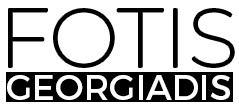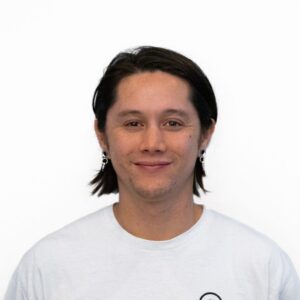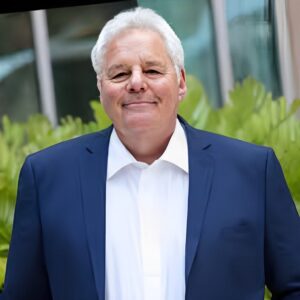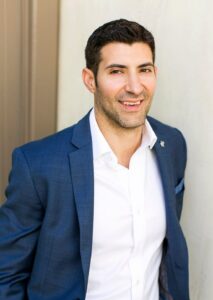The Future Is Now: David Hurwitt Of Troove On How Their Technological Innovation Will Shake Up The Tech Scene
An Interview With Fotis Georgiadis
Be as humble as you are certain. Conviction is essential for any founder. You’re starting from a standing position and asking others to come along and run towards an unclear destination. Everyone knows most of these journeys don’t often go where planned, but as the founder, you have to sell your vision with absolute passion and conviction. You have to be unwavering in not just your vision, but also your ability to get the team there. At the same time, however, there is no way to do that alone and setbacks are going to happen. You have to listen exceptionally well and demonstrate that you’re really hearing the input and adjusting accordingly. Balancing between “I’m sure” and “I was wrong” is a delicate balance, but done with humility and conviction, it helps others vest in the journey and commit even more to the goals.
As a part of our series about cutting-edge technological breakthroughs, I had the pleasure of interviewing David Hurwitt.
David Hurwitt lives in Charlotte, Vermont. He is the founder of Troove, the first technology company to harness the power of alumni and current student experience to connect students with the schools where they are most likely to be happy and successful.
Thank you so much for doing this with us! Can you tell us a story about what brought you to this specific career path?
I’m a third generation MBA, and growing up, our dinner table was like a perpetual focus group. My Dad worked in the food business for General Foods and many nights he would bring home new products in white boxes for us to try. I was one of four kids and he’d watch us as we broke into the latest box and quiz us about what we found. I always loved that exploration and the conversation it generated. Before long I was trying to figure out why the development teams made the choices they did and really boil my answers down to their most insightful and elemental components. I was endlessly curious about both sides of the process — the core customer needs and the solutions to (hopefully!) meet them. It was incredibly creative and challenging at age 10, and it still is today!
Can you share the most interesting story that happened to you since you began your career?
In 2000, I was the Sr. Product Manager of the Whirlpool washer and dryer business. We were trying to figure out why Americans didn’t like front loading washers and hopefully design ones they would. To answer this question, I sent eight 2-person research teams into homes across the country of people who were already using one of the small European front loading washers. We wanted to learn first hand what they liked and disliked. Typically, we paired an engineer with a sales or marketing person and I went into homes in the Seattle area with our engineering head from Europe. In one couple’s semi-finished basement, we were at one end of the room watching a woman in her late sixties, on her hands and knees loading her little washer. As she rose to her feet with a hand on her aching lower back, I asked, “would it be easier if the machine opening was up higher?”. She immediately whipped around, pointed at her husband watching TV in his BarcaLounger at the other end of the room, and said loudly, “I’ve been telling that lazy SoB for years to put this thing up on some cinder blocks!”. After some nervous laughter, I explained that would be dangerous because it wouldn’t be stable, but perhaps in our new design we could create a safe pedestal option. From the other side of the room came a loud, “See!”. 18 months later, we launched the new Duet front loading washer and dryer, and they included pedestals just like we envisioned back in that Seattle basement. 20 years later, they’re still selling like crazy.
Can you tell us about the cutting-edge technological breakthroughs that you are working on? How do you think that will help people?
Only a third of Americans have a bachelor’s degree today and the average 4-year college graduation rate is a mere 44%. After 6-years, it’s just 62%. America has a college graduation problem and we believe the largest contributor to this problem is fit. Kids are ending up at the wrong schools, studying the wrong things, and failing at an alarming rate. Our technology is designed to solve these problems by helping the right people and schools connect.
At their core, schools are collections of people, gathered for a common purpose, and conforming to agreed upon norms. The schools’ academic and social cultures are defined by how they operate and how their members engage with each other. For some people, those norms are ideal, allowing them to flourish in and out of the classroom. For others, they are misaligned, preventing them from achieving the success to which they are entitled. The problem causing this misalignment has always been the opacity of these cultures. It’s easy (and common practice) to subjectively rank schools for all sorts of things, but the industry hasn’t been able to objectively quantify learning and social cultures so proper, persistent fit can be established. That’s what Troove does.
We draw experienced users — recent alumni and current students — into the process for the first time and ask them a range of questions about their academic and social interests, priorities, abilities, and values. This gives us the unique DNA sequence for each school, it quantifies their culture and establishes the success markers for their communities so that applicants can answer the same questions and be matched with the places where they share the most fundamental characteristics with existing community members. After all, graduates have achieved the success coveted by every incoming freshman, so it’s only logical to model their success and use it as a beacon for future students.
How do you think this might change the world?
Education is the great equalizer in society. It is the most important accelerator of social mobility, with a bachelor’s degree estimated to increase lifetime earnings by over 70%. And even more importantly, studies consistently find a direct correlation between health, longevity, and education. A recent long term study by Virginia Commonwealth University showed that having an undergraduate degree or higher versus not completing high school extends life an average of 14 years for men and 10 years for women. It also correlates to lower rates of diabetes, heart disease, and cancer while reducing obesity and smoking.
By matching the right student-school combinations, we throw open these doors of opportunity. And this is especially true for minorities and those without the greatest economic means. The antiquated current college search and admissions system heavily favors wealthier students, especially white ones, who graduate at significantly higher rates with dramatically less debt than their minority and less privileged counterparts. Breaking these cycles instantly starts people more evenly on the path to a degree and over time pulls millions of people into greater affluence, health, and opportunity.
The high school graduation rate in the US has risen to about 90%, while the 4-year college graduation rate is less than half of this at just 42%. A 90% college graduation rate would launch roughly 2 million more graduates into the professional and skilled workforce every year. It would improve health for these people and dramatically improve the chances their children will also go to college. America would be more competitive in a STEM driven future and the age-old promise of America as the land of opportunity would be renewed.
Was there a “tipping point” that led you to this breakthrough? Can you tell us that story?
Having put three kids through college, like most parents, I was well aware that this market was in desperate need of disruption and improvement, so when I came across an interview with the founder of eharmony, the lightbulb really went off for me. He claimed that over a 10-year period, couples who met on eharmony and married (which is some 4% of US marriages each year), had a mere 3.9% divorce rate vs. roughly 50% for the population at large. Wow! Any time you see more than an order of magnitude difference in two methods, pay attention and ask why!
Well, the “why” for eharmony lies in the fact that each new member takes a detailed personality assessment and then is only ever shown profiles of people with whom eharmony has determined there to be the basis for a long term relationship. Where other sites match first on visual attraction, eharmony says no, match first on compatibility and likely persistence and then seek attraction.
It’s really fascinating, and it triggered an idea for me about the college search process. For centuries, we’ve asked kids to come up with a list of schools they’re attracted to and then briefly date (sometimes blind!) before entering into a lifelong relationship. We know that doesn’t work, so what if we followed eharmony’s example and used technology to prequalify lasting fit and then introduce kids (and schools) to the partners with whom science and experience proves they have the greatest possibility of a forever relationship? What would an order of magnitude improvement in college persistence and graduation rates mean for millions of students from now on, not to mention the schools who serve them?
What do you need to lead this technology to widespread adoption?
We have very deliberately built our technology on a huge foundation of existing experience data so it can be really effective right out of the gate. But we’ve also built a data science platform that grows smarter with each new user and data point acquired. So, the simple answer for us is brand awareness. The system is primed for growth and maturity. We just need more users through the system.
The good news is that after two full years of working on this and pitching our core idea to everyone from college presidents and heads of enrollment and alumni relations, to guidance counselors, parents and students currently in the college search and application process, we have yet to run across a single person who hasn’t said some version of, “Well yeah, that makes a ton of sense, why haven’t we always been done it this way?” People just get it, they understand the idea of “what’s past is prologue” and they know how it will help them and their schools. So, we just need to tell more people we’re here to help.
What have you been doing to publicize this idea? Have you been using any innovative marketing strategies?
This is a two-sided market, with schools on one side and applicants on the other. As a technology whose benefits reach far beyond the admissions office, the school side for us includes presidents, provosts, VPs of Alumni Development and Admissions, not to mention school guidance counselors and private college consultants. On the applicant side, high school students, transfer students, their parents, as well as adults looking to go back to college are all part of our market. So, we have a lot of ground to cover! There’s no question however, that the key at this stage is the applicants and we’re choosing to start with the largest group of them — high school juniors and seniors. This is roughly 8 million US students and millions more internationally.
Not surprisingly, we’ve taken a content driven, video strategy, producing a series of interview style videos featuring real kids struggling with the rollercoaster of emotions and challenges they have in the college search and application process. We want real kids talking to real kids. Deciding to go to college, applying, and selecting one are really their first adult decisions and we want to treat them that way, like capable young adults making hard choices. They have enough adult voices telling them what to think and do in their lives — parents, teachers, coaches, guidance counselors…. We want Troove to be their brand. We want to trust them and support them. That has to come through in everything from product and web design to marketing communications. That’s why we’ve focused out launch marketing in particular on kids talking to kids, presenting Troove in a context they can relate to (one student refers to Troove as “like a dating app for college.”) So far, this is really resonating well with our audience and the social engagement has been great.
None of us are able to achieve success without some help along the way. Is there a particular person who you are grateful towards who helped get you to where you are? Can you share a story about that?
As a founder from outside the higher education industry, I knew a first step for me was building a network of industry experts. I spent months networking, cold calling, and reaching out to people whose research I was reading. This was at the very beginning of Covid, so I actually found a lot of people willing to talk and jump on Zoom calls. Suddenly, getting on a video call with a stranger seemed less strange!
One of the people I met through this process was Ian Mortimer, VP of Enrollment and Associate Provost at Rochester Institute of Technology, one of the largest private universities in America. Ian is a very progresssive thinker and he instantly saw even more value and opportunity in my core hypothesis than I did. Decades in higher ed admissions had shown him the frustrating disconnect within schools between the teams serving their alumni and their applicants, and he clearly articulated for me the system-wide benefits of greater connection. In fact, in one of our first calls, I told him I had already come up with a great brand name — AdmitsU. I figured as an admissions guy, he would love it as much as I did, but a few days later, he called me and said, “you have to change your name.” When I pressed him about why — after all I had come up with this name and already loved it — he explained that we’d be short changing the benefits of our breakthrough. He said we needed to understand and sell our idea as a university-wide application with direct and tangible benefits from admissions, to retention, graduation, and alumni engagement. The name had to go. It took me a few hours to get over my attachment to AdmitsU, but later that day, I texted him and simply wrote, “Shit, you’re right!”.
Ever since, Ian has been an invaluable sounding board and advocate for us, introducing us to other industry professionals, sharing published research, and agreeing to have RIT participate as one of our Beta schools at launch.
What are your “5 Things I Wish Someone Told Me Before I Started” and why.
1. Be as humble as you are certain. Conviction is essential for any founder. You’re starting from a standing position and asking others to come along and run towards an unclear destination. Everyone knows most of these journeys don’t often go where planned, but as the founder, you have to sell your vision with absolute passion and conviction. You have to be unwavering in not just your vision, but also your ability to get the team there. At the same time, however, there is no way to do that alone and setbacks are going to happen. You have to listen exceptionally well and demonstrate that you’re really hearing the input and adjusting accordingly. Balancing between “I’m sure” and “I was wrong” is a delicate balance, but done with humility and conviction, it helps others vest in the journey and commit even more to the goals.
2. Trees and forests both matter. As efficiently as possible, the role of the founder is to run back and forth between tiny detail and overarching strategy. There are prolonged periods where each dominates and vacillation is counterproductive, but both are essential to success. No detail is too small and showing the team that you are engaged at that level builds a powerful connection and increases trust. But while many people are likely focused on a spectrum of details, you’re the owner of the vision, the person who provides context and helps the team see the ultimate value and potential for their work. This gives them greater courage to innovate and drive the details and invariably enhances the vision in ways you hadn’t even imagined.
3. Make yourself as uncomfortable as possible, as often as possible. Everyone’s natural instinct is to play to their strengths. This often translates into spending time on the things you’re good at or simply like doing, and those aren’t always the things that need doing in the moment. Resources are scarce at founding and we all wear many hats. For me, as a solo founder, this has been especially true and has required that I actively press myself into areas of weakness, ignorance, and reliance on others — three things I’m not naturally fond of! I’ve discovered, however, that I actually like many of these things and slaying these dragons is empowering and enriching.
4. The boogeyman is real. I am, by nature, a positive person. My first instinct is to trust and see the good in people and circumstances. That’s usually a strength, but it can also mean I get caught by surprise when things don’t go as planned. Sometimes, forces and people conspire against you. They just do. For reasons you couldn’t, or simply didn’t foresee, the plan gets blocked or simply goes off the rails you’ve carefully built. That’s OK! Never plan to fail, but always game out what might fail, have plans, or at least tools on hand for when they do, and respond quickly. Don’t be surprised by roadblocks, be prepared for them.
5. This will be the most fun you’ll have in your career. Like most founders, I’ve had a thousand ideas for companies. What makes this one perfect for me is not just its strong product-market fit or its ability to positively impact the lives of millions, it’s that it allows me to flex all of my talents while requiring that I develop a bunch of new ones I’m really loving. I spend most days doing fascinating things I deeply care about and that’s such a gift!
If you could inspire a movement that would bring the most amount of good to the most amount of people, what would that be?
Years ago, while I was in the renewable energy industry, I heard Bill Gates speak at a conference. He said, “I guess you’re probably wondering what I’m doing here! After all, energy isn’t really my thing. Well, energy empowers my thing. By electrifying the world, especially the underdeveloped world, we can bring healthcare and education to everyone. That’s my thing.” That idea of focusing on ‘what powers your dream’ stuck with me and I see that as what we’re doing at Troove. There is a massive amount of research to prove that attaining a college degree allows people to live longer, healthier, more rewarding and impactful lives. It’s a benefit they pass on to their children, and it lifts millions of people into lives they previously only dreamed of.
Can you please give us your favorite “Life Lesson Quote”? Can you share how that was relevant to you in your life?
Gandhi was right when he said, “Be the change you want to see in the world”. It allows for action, which I prefer. It’s available to everyone, which I value. And it’s inherently positive, which is actually part of the change I want to see. When combined with words of the same meaning, you have a powerful, authentic combination and the perfect foundation for both leadership and high functioning teams. Absent that consistency, however, look out!
Some very well known VCs read this column. If you had 60 seconds to make a pitch to a VC, what would you say?
Have you ever heard anyone say, “college admissions sure is a great process!” We haven’t either and it’s time to change that.
College admissions is the $10 billion gateway to the trillion dollar higher education market. After nearly 400 years of following the same basic admissions process, Troove disrupts and significantly improves this system by introducing the matching capabilities of modern, AI-driven data science, already well proven in markets from dating to shopping.
For the first time, we directly connect the two largest parts of every school community — the applicants and the alumni. The alumni have achieved the success coveted by every incoming freshman and cumulatively, their experiences in and out of the classroom contain the unique success codes for their schools. Troove is the SaaS platform that unlocks these codes and introduces students to the schools where they are most likely to fit, stay, and succeed. This drives significant improvements from admissions yields to graduation and alumni engagement rates, reaping massive rewards for schools and improving access and graduation rates for students.
Troove launched in October, 2021 and will begin seeking a Seed round in early 2022.
Thank you so much for joining us. This was very inspirational.
The Future Is Now: David Hurwitt Of Troove On How Their Technological Innovation Will Shake Up The… was originally published in Authority Magazine on Medium, where people are continuing the conversation by highlighting and responding to this story.



